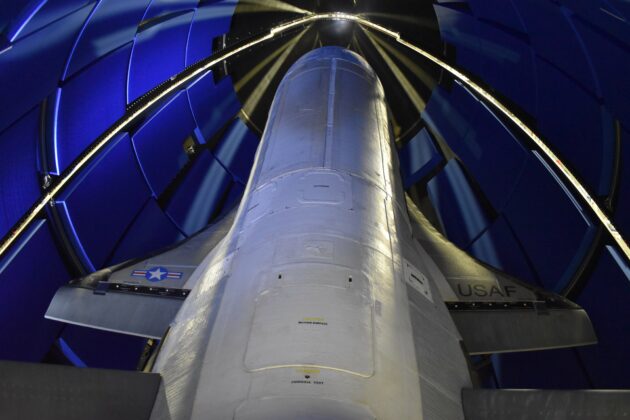
When a Boeing-built X-37B space plane is sent into orbit this month for the test program’s sixth flight, it will try out a technology that’s been more than a decade in the making: space-based solar power.
An experiment designed by the U.S. Naval Research Laboratory will transform solar power into a microwave beam that could be transmitted down to the ground. If such a power-beaming system could be perfected, concentrated microwave energy from space could conceivably be converted to electricity for far-flung military outposts.
Back in 2007, the Pentagon issued a report saying the U.S. military could be an “anchor tenant customer” for space-based power generation systems. That report piggybacked on a NASA study that was written a decade earlier, assessing the feasibility of wireless power transmission from space.
The X-37B’s power-beaming experiment would follow up on a small-scale test that was conducted aboard the International Space Station in February. During that demonstration, astronauts made use of the Naval Research Laboratory’s light-emitting rectifying antenna, known as LEctenna, to convert a wireless data signal into enough electrical power to make an LED light glow.
The X-37B program itself is a grand experiment. Over the course of the past decade, the Pentagon’s two space planes have taken on five autonomous test missions in orbit, including a marathon flight that lasted 780 days and ended with a runway landing last October. The program’s total time spent in space adds up to 2,865 days — or seven years and 10 months.
In the past, the stubby-winged craft has been launched into space on United Launch Alliance’s Atlas 5 rocket or SpaceX’s Falcon 9 rocket. The next launch will be atop an Atlas 5, set for liftoff from Cape Canaveral Air Force Station in Florida on May 16.
The reusable space plane’s purpose has been somewhat shrouded in secrecy, but in recent years, military officials have been more forthcoming about its use as a testbed for military space technologies — including novel approaches to propulsion and communications.

“This X-37B mission will host more experiments than any prior missions,” Air Force Secretary Barbara Barrett said today in a news release. “This launch also demonstrates the department’s collaboration that pushes the boundaries for reusable space systems.”
Although the mini-space shuttles are considered assets of the Department of the Air Force, the recently created U.S. Space Force will be in charge of launch, on-orbit operations and landing for this mission, known as OTV-6 or USSF-7.
Gen. John “Jay” Raymond, the Space Force’s chief of space operations, said the X-37 team “continues to exemplify the kind of lean, agile and forward-leaning technology development we need as a nation in the space domain.”
This will be the first X-37B to host experiments in a service module attached to the aft of the plane.
“The incorporation of a service module on this mission enables us to continue to expand the capabilities of the spacecraft and host more experiments than any of the previous missions,” said Randy Walden, director and program executive officer for the Department of the Air Force Rapid Capabilities Office.
In addition to the power-beaming experiment, the X-37 will carry two NASA experiments aimed at gauging the effects of the high-radiation space environment on samples of spacecraft materials and on seeds used to grow food.
The mission will also deploy FalconSat-8, a small satellite developed by the U.S. Air Force Academy and sponsored by the Air Force Research Laboratory. FalconSat-8 will carry five experimental payloads, including an advanced thruster system.



